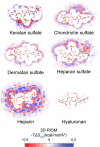Distribution and Function of Glycosaminoglycans and Proteoglycans in the Development, Homeostasis and Pathology of the Ocular Surface
- PMID: 32903857
- PMCID: PMC7438910
- DOI: 10.3389/fcell.2020.00731
Distribution and Function of Glycosaminoglycans and Proteoglycans in the Development, Homeostasis and Pathology of the Ocular Surface
Abstract
The ocular surface, which forms the interface between the eye and the external environment, includes the cornea, corneoscleral limbus, the conjunctiva and the accessory glands that produce the tear film. Glycosaminoglycans (GAGs) and proteoglycans (PGs) have been shown to play important roles in the development, hemostasis and pathology of the ocular surface. Herein we review the current literature related to the distribution and function of GAGs and PGs within the ocular surface, with focus on the cornea. The unique organization of ECM components within the cornea is essential for the maintenance of corneal transparency and function. Many studies have described the importance of GAGs within the epithelial and stromal compartment, while very few studies have analyzed the ECM of the endothelial layer. Importantly, GAGs have been shown to be essential for maintaining corneal homeostasis, epithelial cell differentiation and wound healing, and, more recently, a role has been suggested for the ECM in regulating limbal stem cells, corneal innervation, corneal inflammation, corneal angiogenesis and lymphangiogenesis. Reports have also associated genetic defects of the ECM to corneal pathologies. Thus, we also highlight the role of different GAGs and PGs in ocular surface homeostasis, as well as in pathology.
Keywords: cornea; decorin; keratan sulfate; lumican; wound healing.
Copyright © 2020 Puri, Coulson-Thomas, Gesteira and Coulson-Thomas.
Figures







Similar articles
-
Corneal cell proteins and ocular surface pathology.Biotech Histochem. 1999 May;74(3):146-59. doi: 10.3109/10520299909047967. Biotech Histochem. 1999. PMID: 10416788 Review.
-
Matrix glycosaminoglycans in the growth phase of fibroblasts: more of the story in wound healing.J Surg Res. 2000 Jul;92(1):45-52. doi: 10.1006/jsre.2000.5840. J Surg Res. 2000. PMID: 10864481
-
[Amniotic membrane graft in ocular surface disease. Prospective study with 31 cases].J Fr Ophtalmol. 2001 Oct;24(8):798-812. J Fr Ophtalmol. 2001. PMID: 11894530 French.
-
The Human Cornea: Unraveling Its Structural, Chemical, and Biochemical Complexities.Chem Biodivers. 2025 Apr;22(4):e202402224. doi: 10.1002/cbdv.202402224. Epub 2024 Dec 11. Chem Biodivers. 2025. PMID: 39559954 Review.
-
[The cornea: stasis and dynamics].Nippon Ganka Gakkai Zasshi. 2008 Mar;112(3):179-212; discussion 213. Nippon Ganka Gakkai Zasshi. 2008. PMID: 18411711 Review. Japanese.
Cited by
-
Advances in Polysaccharide-Based Microneedle Systems for the Treatment of Ocular Diseases.Nanomicro Lett. 2024 Aug 13;16(1):268. doi: 10.1007/s40820-024-01477-3. Nanomicro Lett. 2024. PMID: 39136800 Free PMC article. Review.
-
Cellular Stress in Dry Eye Disease-Key Hub of the Vicious Circle.Biology (Basel). 2024 Aug 28;13(9):669. doi: 10.3390/biology13090669. Biology (Basel). 2024. PMID: 39336096 Free PMC article. Review.
-
Integration of a miniaturized DMMB assay with high-throughput screening for identifying regulators of proteoglycan metabolism.Sci Rep. 2022 Jan 20;12(1):1083. doi: 10.1038/s41598-022-04805-y. Sci Rep. 2022. PMID: 35058478 Free PMC article.
-
The role of corneal endothelium in macular corneal dystrophy development and recurrence.Sci China Life Sci. 2024 Feb;67(2):332-344. doi: 10.1007/s11427-023-2364-3. Epub 2023 Jul 11. Sci China Life Sci. 2024. PMID: 37480470
-
Clinical outcomes of modified simple limbal epithelial transplantation for limbal stem cell deficiency in Chinese population: a retrospective case series.Stem Cell Res Ther. 2021 May 1;12(1):259. doi: 10.1186/s13287-021-02345-2. Stem Cell Res Ther. 2021. PMID: 33933149 Free PMC article.
References
Publication types
Grants and funding
LinkOut - more resources
Full Text Sources

